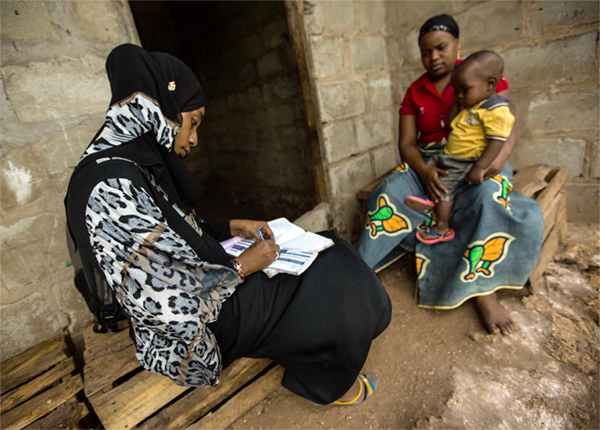Introduction
The Scaling Up Nutrition (SUN) Movement’s 2013 Progress Report pointed to the importance of in-country resource availability and mobilization, and highlighted the challenges countries face in tracking resources destined for nutrition programming. The success of national nutrition plans relies heavily on adequate funding, but because of its multisectoral nature, planning and budgeting for nutrition work is not easy. In addition, despite recognition that creating and sustaining financial support for nutrition is critical, data on nutrition allocations remain limited. Nutrition advocates lack access to accurate and timely financial data, which impacts their ability to ensure adequate nutrition resources.
To address these important gaps, SUN developed a three-step approach to report on nutrition-relevant allocations in national budgets. In addition, based on SUN’s approach, the SPRING project has developed an easy-to-use tool that breaks SUN’s three steps into seven detailed actions. Like SUN’s approach, SPRING’s tool is designed for nutrition stakeholders, to help them determine where the funding for nutrition is, understand existing resource gaps, and advocate for adequate budgets.
Box 1. Where did the Budget Analysis Tool come from?
The “Pathways to Better Nutrition” (PBN) case study, being conducted by the USAID-funded SPRING Project, is following the rollout of national nutrition plans in Uganda and Nepal over a two year period (2013–2015) and over two budget cycles (2013/14, 2014/15) to explore the prioritization and funding of nutrition interventions. This tool builds on budget analysis efforts undertaken in the course of the study.
Resources and findings, including further details on budget analysis methodology, are available on the SPRING PBN webpage. SPRING's budget methodology for the study is based on the SUN three-step process, details of which are on the SUN budget webpage.

This user’s guide provides necessary background information for undertaking the budget analysis process, which identifies and analyzes nutrition allocations using a Microsoft Excel-based Budget Analysis Tool available for download on the SPRING website at www.spring-nutrition.org/budget-tool. The tool was designed for government officials, members of civil society, and other nutrition stakeholders to estimate the amount of funding available for nutrition programming within a ministry, unit, department, or district1. The tool can be used across multiple ministries or donors to provide a more comprehensive picture of national nutrition allocations, or can be used within a single organization.
While the process detailed in this user’s guide is not the only option for tracking nutrition financing commitments, it is one that can be completed in varied resource settings and will result in validated estimates of funds available for nutrition work. To carry out this exercise, we recommend forming a budget analysis team of one or more people with experience in budget analysis, nutrition planning, and nutrition advocacy.
Organization of This User’s Guide

- Before starting the analysis, review the “Budget Terminology” section directly below to familiarize yourself with basic budget terms used herein. These terms will also be useful in conversations with budget or planning staff.
- The “Technical Background” section will help ensure that you are familiar with the basics of budget analysis and nutrition, and are ready to begin the exercise.
- The “Budget Analysis Process” section includes seven steps and provides a guide for budget tracking, which can point you to what funding has been allocated for implementation of nutrition activities.
- The “Using the Budget Analysis Tool” section will walk you through SPRING’s Budget Analysis Tool, provide descriptions of the various tabs and columns, as well as examples of how to use the tool.
- SPRING relied heavily on the wealth of existing knowledge around budget analysis and nutrition to do its work, and links to these resources are shared throughout the document. The “Resources Center” section at the end of this document lists all relevant links for easy access. You can also find this information in the “References List.”
- The Excel-based “Budget Analysis Tool” is available for download separately from this user’s guide. It has been developed to be used for both data collection and analysis.
Box 2. Looking for related work?
The 2014 Global Nutrition Report described efforts to track nutrition financing in Guatemala, Madagascar, and Tanzania (IFPRI 2014). The SUN webpage on budget analysis includes updates on ongoing country efforts to track financial allocations for nutrition.
Budget Terminology
To collect the right data and obtain results, you will need to know certain characteristics of each budget line you include in the tool. The list below provides descriptions of key terms you will need as you proceed with this analysis. Although the list does not include all budget terms, it will help you get started and is especially useful for the data extraction step of the budget analysis process (Step 4). Throughout the text, these key terms have been italicized to remind you to refer here for the definition. These terms will also be needed to complete the Budget Analysis Tool.
On-budget: Funds are run through the Treasury. For donors, this means that their funded activity receives a government program or project code, and is included in government planning and budget documents.

Off-budget: Funds are run outside of the Treasury and are not included in the regular government budget.
Integrated: The budget line includes a number of activities, and the nutrition-relevant activity is only a portion of the total amount reflected in the budget line.
Stand-alone: The budget line includes only nutrition-relevant activities, so nutrition-relevant activities make up the total amount reflected in the budget line.
Nutrition-specific: These are interventions that directly address the causes of malnutrition, including care, health, and feeding practices. These activities are often addressed within the health sector. Unless you have a good reason to do otherwise, nutrition-specific interventions can be defined as those listed in the 2013 Lancet series (Bhutta 2013):
- Pre-conception folic acid supplementation or fortification
- Maternal multiple micronutrient supplementation
- Maternal balanced energy and protein supplementation
- Maternal calcium supplementation
- Promotion of breastfeeding
- Appropriate complementary feeding
- Vitamin A supplementation
- Preventative zinc supplementation
- Management of severe acute malnutrition
- Management of moderate acute malnutrition
Nutrition-sensitive: These are interventions that indirectly address the causes of malnutrition, including food security/availability, resources for feeding and caregiving, and access to health services. These activities are often addressed in sectors such as agriculture, education, social development, and trade. Practically speaking, nutrition-sensitive interventions may encompass all those activities that are nutrition-related, but are not in the list of nutrition-specific activities above.
Read the next section
Footnotes
1 This user’s guide uses the term “ministry;” however, this tool could be used for analysis of a national, district, unit, or department budget. To ensure the quality of data and avoid duplication of effort, it is important to clarify the parameters or reach of this analysis before you begin the process.
References
Black RE, Victora CG, Walker SP, and the Maternal and Child Nutrition Study Group. 2013. “Maternal and child undernutrition and overweight in low-income and middle-income countries.” The Lancet. http://dx.doi.org/10.1016/S0140-6736(13)60937-X.
Fracassi, Patrizia, and Clara Picanyol. 2015. “Tracking Government Investments for Nutrition at Country Level.” http://scalingupnutrition.org/wp-content/uploads/2015/02/150130_EN_SUMMA....
Horton, Susan, and Weltbank, eds. 2010. Scaling Up Nutrition: What Will It Cost?. Directions in Development Human Development. Washington, D.C: World Bank.
International Budget Partnership. 2014. “20 Key Questions About Your County Budget: A Citizens’ Tool for Reading and Understanding County Budgets.” http://internationalbudget.org/publications/20-key-questions-about-your-....
International Food Policy Research Institute. 2014. “Global Nutrition Report 2014: Actions and Accountability to Accelerate the World’s Progress on Nutrition.” http://globalnutritionreport.org/the-report/.
Lakin, Jason. 2012. “A Citizens Guide to Understanding and Using Inflation for Budget Analysis.” http://openbudgetsgame.org/inflationguide/.
Lancet. 2008. “2008 Lancet Series : Maternal and Child Undernutrition.” http://www.thelancet.com/series/maternal-and-child-undernutrition.
———. 2013. “2013 Lancet Series: Maternal and Child Nutrition.” http://www.thelancet.com/series/maternal-and-child-nutrition.
Scaling Up Nutrition. 2013a. “SUN Donor Network Resource Tracking.” In SUN Movement Annual Progress Report 2014, 38–41. http://scalingupnutrition.org/wp-content/uploads/2014/11/141117-SUN-Dono....
———. 2013b. “State of the SUN Movement Progress Report.” http://scalingupnutrition.org/wp-content/uploads/2014/05/SUN-Progress-Re....
———. n.d. “Guidance Note Step 2 (categorization) and Step 3 (weighting).” http://scalingupnutrition.org/wp-content/uploads/2015/05/150406_Guidance....
———. 2015a. “Scaling Up Nutrition.” http://scalingupnutrition.org/.
———. 2015b. “Budget Analysis.” http://scalingupnutrition.org/about/financial-tracking-resource-mobiliza....
Shapiro, Isaac, ed. 2001. “A Guide to Budget Work for NGOs.” International Budget Partnership. http://internationalbudget.org/publications/a-guide-to-budget-work-for-n....
SPRING. 2015. “Pathways to Better Nutrition Case Studies.” https://www.spring-nutrition.org/about-us/activities/pathways-better-nut....
Scaling Up Nutrition. 2015. “Tanzania Develops the First Public Expenditure Review for Nutrition.” Scaling Up Nutrition. Accessed October 14. http://scalingupnutrition.org/news/tanzania-develops-the-first-public-ex....
SUN Donor Network. 2013. “SUN Donor Network: Methodology and Guidance Note to Track Global Investments in Nutrition.” http://scalingupnutrition.org/wp-content/uploads/2013/12/RESOURCE_TRACKI....
UNICEF. 1990. Strategies of Improving Nutrition of Children and Women in Developing Countries. New York, NY: UNICEF.
USAID. 2014. “Multi-Sectoral Nutrition Strategy 2014-2025.” http://www.usaid.gov/sites/default/files/documents/1867/USAID_Nutrition_....
The World Bank. n.d. “Open Budget Portal | Public Expenditure Review | The World Bank.” http://wbi.worldbank.org/boost/tools-resources/public-expenditure-review.
———. n.d. “Participation & Civic Engagement - Public Expediture Tracking Survey (PETS).” http://web.worldbank.org/WBSITE/EXTERNAL/TOPICS/EXTSOCIALDEVELOPMENT/EXT....
World Health Organization. 2015a. “WHO | Health Accounts.” WHO. Accessed October 14. http://www.who.int/health-accounts/en/.
———. 2015b. “WHO | OneHealth Tool.” WHO. Accessed October 14. http://www.who.int/choice/onehealthtool/en/.